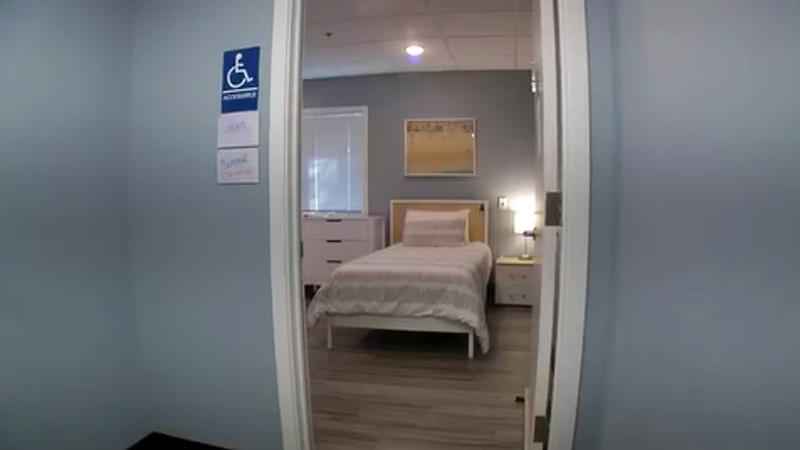‘We are in an epidemic’: Inside a substance use disorder detox clinic
[anvplayer video=”5065167″ station=”998122″]
It begins with a phone call.
"Are you currently experiencing any active withdrawal symptoms?" Sam Castillo asks a caller. "When was your most recent day of use?"
With his headset and computer, the 22-year old admissions coordinator at Gateway Recovery Center in Inver Grove Heights is often the first voice a caller hears. He handles up to 70 calls per day from people hoping to get medically detoxed, to get their bodies clean of drugs.
"A lot of the time, we’re doing intake screening, we’re discussing substance abuse history with that individual," Castillo explained.
He says their stories involve everything from alcohol to opioids.

[KSTP]
"The scary thing nowadays that I’m seeing is that people are buying heroin and overdosing on fentanyl without knowing about it," Castillo noted. "And now they’re in the hospital on an overdose and it’s fentanyl."
The 18-bed facility opened in July 2020, in the midst of the pandemic. Since then, Gateway says it’s treated 1,400 people — at full capacity for the last seven months.
"We are in an epidemic. We are experiencing a major crisis when it comes to drug addiction and substance use disorder," Drew Horowitz, Gateway’s founder and CEO, declared.
"Every month, our call volume increases 25-30%. Now, we’re at 2,200 calls per month," he added. "On any given month, we’re sending a hundred and something people out for additional care, from here for additional care."
The Minnesota Department of Health says 1,008 people died from drug overdoses in 2020; of those, 654 cases involved opioids, a 59% increase from 2019.
"We opened at the height of the pandemic, and we see a large call volume of individuals dependent on opioids," Horowitz said.
He adds that one-third of Gateway’s caseload involves treatment for opioids like heroin, fentanyl and oxycodone. Half their cases, Horowitz says, involve alcohol abuse.
"People use substances to cope with anxiety, stress, the loss of a job, anything like that," said Mike Beltowsky, Gateway’s director of admissions.
He says the pandemic was a huge aggravating factor.
"A lot of people can hide use," Beltowsky explained. "They’re not going to work, now they’re working from home, and people, you know, find any reason to use earlier in the day or more, because there’s less eyes on it."
To help in the detox effort, Horowitz says he wanted Gateway to feel different; less like a medical facility, and more like home.
"I really felt it was important that people felt comfortable," Horowitz said. "That they didn’t feel like they were in an institution, that they could see out the windows."
Clients typically stay an average of four days, Horowitz says. A medical team supervises the dispensing of pain and withdrawal medications.
"So we’re hydrating them, we’re feeding them," Horowitz said. "We’re providing medications and rest, in order to nourish them so their bodies can start to heal."
There’s also group counseling and peer support sessions, according to Beltowsky.
"That includes programming seven days a week, meditation, evening reflection. We do group twice a day," he added. "And providing a place for community for conversation creates engagement, where people can relate to one another."
For staffers, the work is personal. Many are in recovery or have friends or family affected by substance abuse.
Horowitz said he was addicted to drugs and alcohol before his sober date 10 years ago.
"A really volatile and dangerous addiction," he said. "Fortunately, with the help of my family, I was able to access treatment, and through that process, became motivated to help others."
That brings us back to Castillo.
"When I get these calls, I just treat it like this is a family member that needs our help," Castillo said quietly.
Castillo said his uncle died from cocaine and heroin abuse in 2009 and his mother, Lynn Jaspersen, used heroin and methamphetamine. She’s been drug-free for several years, he says proudly.
"With, like, my mom’s experience, she’s four years clean," Castillo explained. "She’s been out of my childhood and life for quite a bit of time, in and out. And we have the best relationship ever. That is one-on-one, totally love my mom."
The detox process is just the start for people in recovery.
Horowitz says the symptoms of withdrawal can be very painful. Nausea, vomiting, sweating, anxiety — all part of it.
Gateway says it provides post-detox placement for clients. Among many options are residential in-patient programs, partial hospitalization and sober living facilities. Many have peer counseling and treatment programs that can last a year.
Horowitz believes his approach is making a difference but he also says the issue of substance use disorder isn’t going away.
"I think what’s most important is we reduce stigma. We make sure people know there is help available, and that we take the punitive nature of out of the treatment of substance use disorder," he said. "Everything we’re seeing says that this is going to continue to climb, and the need is going to continue to be there, sadly."